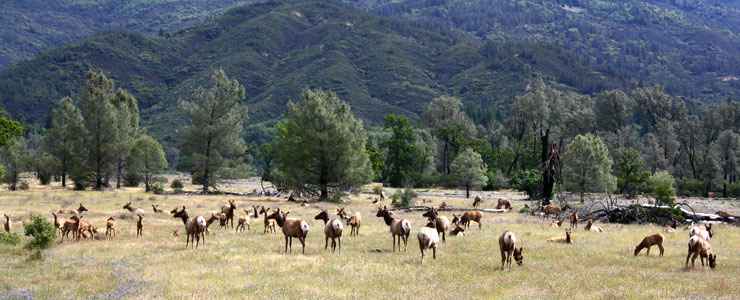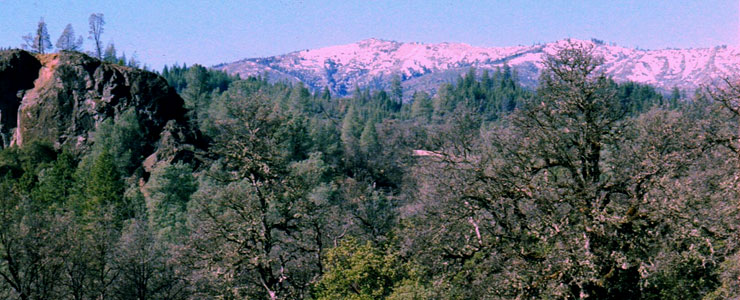Mendocino National Forest

Tule elk near Lake Pillsbury on Mendocino National Forest
Mendocino National Forest has the distinction of being the only National Forest in California that doesn't have a major paved road entering into it anywhere. The 913,306-acre property is located in the Coastal Mountain Ranges of northern California. The forest is roughly 65 miles long and up to 35 miles across, straddling an eastern spur of the Coastal Mountain Range in northwestern California.
President Theodore Roosevelt first set aside this property as part of the Stony Creek Forest Reserve in February, 1907. A month later it became the Stony Creek National Forest but once the government realized how hard it was going to be to manage a tract of land that large, the northern section was broken off and added to other land to make up Trinity National Forest. The southern section then became California National Forest in July, 1908 and kept that name until President Herbert Hoover changed the name to Mendocino National Forest in July, 1932.
The Red Bluff Recreation Area and the Genetic Research Center are two properties non-contiguous with the main forest but are managed by Mendocino National Forest staff. The Genetic Research Center was acquired by the National Forest Service in 1974 and has been used to develop and produce new strains of trees that have been used extensively in the Pacific Southwest Region's reforestation program. The Center is also involved in research on anti-cancer drugs derived from plants. The Red Bluff Recreation Area is a 488-acre parcel east of the main forest straddling the Sacramento River. In addition to the Sacramento River Discovery Center, Red Bluff offers day-use areas, a boat ramp, a campground and four miles of trails that offer great views of Mount Lassen, Mount Shasta and the Yolla Bolly Mountains.
Among all the acreage, the USDA Forest Service estimates there is only about 60,000 acres of old growth tree cover left, everything else having been logged. Among the old growth is Coast Douglas fir, white fir, Ponderosa pine, tan oak and Pacific madrone. Elevations range from a low around 750 feet to a high on the summit of South Yolla Bolly Mountain at 8,092 feet.

The Sanhedrin Mountains
Wilderness Areas
This area of California was inhabited by members of the Yuki, Nomlaki Wintu, Patwin Wintu, Northeastern Pomo and Eastern Pomo tribes for thousands of years before the Anglo-Americans arrived during the 1849 Gold Rush. The area attracted loggers and sawmill operators almost immediately as they saw an opportunity to feed the construction booms in the mining areas and around San Francisco Bay. Copper mining did occur on the Forest before the turn of the century and there was a small resurgence in prospecting for manganese and chrome during World War II but the primary mineral interests in the area centered around several steaming hot springs: visitors would come for many miles to enjoy a soak in the pools of resorts and spas that sprang up quickly in the area.
The only sizable lake on the Forest is Lake Pillsbury with more than 2,000 acres of water surface. Getting to anywhere on the Forest takes time as the Forest is located away from all major highways and many areas can only be approached via dirt and gravel roads. There is an extensive system of off-highway vehicle trails in some areas of the Forest in addition to the hundreds of miles of developed hiking trails.
Mendocino and Los Padres National Forests have been instrumental in bringing the Tule elk back from the brink of extinction. Tule elk were almost everywhere in California until the time of the 1849 Gold Rush, then incoming miners (and others) hunted the species almost to extinction. The California Department of Fish and Game reintroduced Tule elk to the Lake Pillsbury Basin at the foot of Hull Mountain in the late 1970's and the herd has done well, growing steadily until now there are more than 100 elk in the area. California Fish and Game feels good enough about the stability of the herd that they allow a 10-day hunting season to happen beginning on the second Wednesday in September each year.

Rattlesnake Creek

Top photo courtesy of Wikipedia userid CrabTree13, CCA-by-SA 3.0 License
Other photos courtesy of Marcia Wright, CCA-by-SA 3.0 License
Map courtesy of the US Forest Service, modified by TheArmchairExplorer